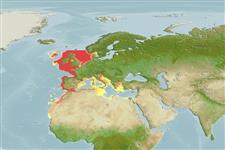Classification / Names
Common names from other countries
Main reference
Size / Weight / Age
Max length : 71.0 cm TL male/unsexed; (Ref. 41333); 68.0 cm TL (female); common length : 40.0 cm TL male/unsexed; (Ref. 3261)
Length at first maturity
Lm 57.5, range 45 - 71.8 cm
Environment
Marine; demersal; depth range 20 - 500 m, usually 20 - 250 m (Ref. 11284)
Climate / Range
Subtropical, preferred 20°C (Ref. 107945); 60°N - 15°N, 18°W - 36°E
Distribution
Short description
Dorsal
spines
(total): 0;
Anal
spines: 0;
Anal
soft rays: 0. Snout short; upper surface entirely spinulose, but centre of pectoral fins more or less bare in adults, underside smooth except for prickly front edges; generally 9-13 thorns in a complete row around inner margin of eye, and a large triangle of thorns on nape or shoulder region; two parallel rows of strong thorns on each side of midline along tail; upper surface ochre to light greyish-brown with a large roundish black eye-spot in middle of each pectoral fin, underside white (Ref. 3167)
IUCN Red List Status (Ref. 115185)
Threat to humans
Harmless
Human uses
Fisheries: commercial; aquarium: public aquariums
More information
ReferencesAquacultureAquaculture profileStrainsGeneticsAllele frequenciesHeritabilityDiseasesProcessingMass conversion
Tools
Special reports
Download XML
Internet sources
Estimates of some properties based on models
Phylogenetic diversity index
PD50 = 0.5000 many relatives (e.g. carps) 0.5 - 2.0 few relatives (e.g. lungfishes)
Trophic Level
4.2 ±0.3 se; Based on diet studies.
Resilience
Low, minimum population doubling time 4.5 - 14 years (K=0.11-0.16; tm=8-9; tmax=28; Fec<100)
Vulnerability
High vulnerability (62 of 100)
Price category
